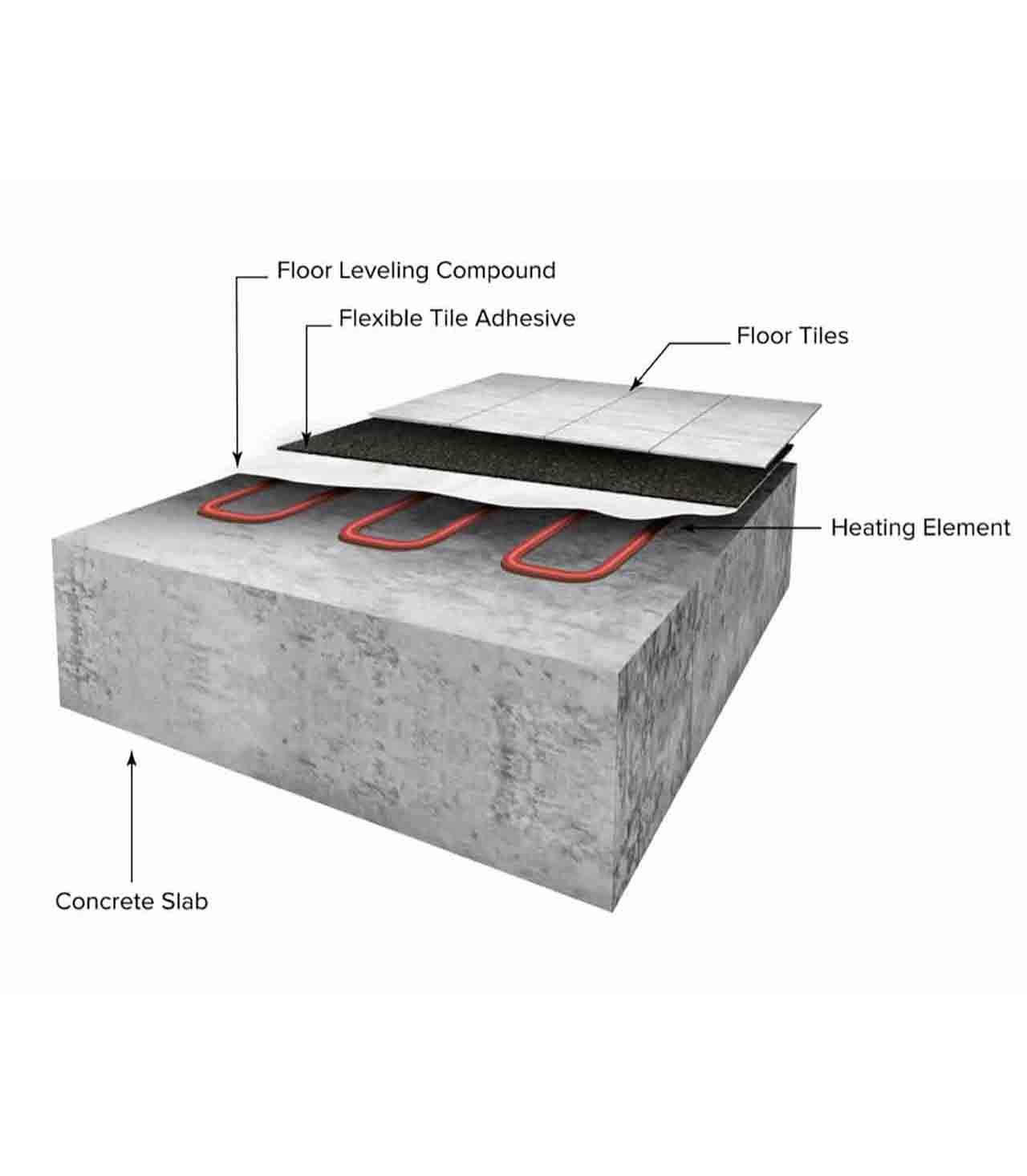Undertile Heating

Undertile Heating
This system is best suited for general floor applications, for example; Kitchens, Dining, Living, Alfresco etc… Where you lay the heating element (cable) and also the thin levelling compound that comes with the kit.
Undertile heating means no ugly hardware. The look, feel and atmosphere of the whole room is enhanced.
Undertile heating has several hidden benefits. No more dampness, wheezing heat pumps, draughts and condensation. It’s no wonder Warmtech’s radiant heating is recommended by health professionals as a treatment for asthma sufferers. It also reduces the site of mould in your wet areas as the space remains constantly dry and warm when turned on.
SHOP NOWEfficient
Undertile heating warms the floor surface where you require it. Combining correct control with the correct installation gives you a cost effective heating system, with no more cold spots or chilly draft.
No Maintenance or annual checks. Simply turn on and enjoy.
Undertile Heating BrochureThe running costs are comparable to fan heaters and often are less than the cost of one coffee per week
These heating elements use 200 – 3000 watts, depending on the size of the room.
Electric underfloor heating provides more additional benefits than any other form of home heating. Used either as a primary heating source for whole house heating or as comfort heating to keep the chill off your cold floors, Warmtech has the electric underfloor heating system for you. Whether you are a contractor looking to install underfloor heating in a large development or a homeowner looking to install underfloor heating in a single room, Warmtech has the products and support to make your project run smoothly. With Warmtech, a complete installation can be achieved in hours without the need for specialist tools or skills.
Running Cost Calculator
PLEASE NOTE. This is intended as a guide only and is dependent on Ausgrid Energy prices. The above calculation is based @ 26¢/kwatt/hr. We have assumed that the heating is ‘ON’ for 6 hours a day (3 hours in the morning and 3 hours at night). Cost per month has been calculated @ 31 days per month. Every 1°C reduction in the temperature setting of your thermostat will result in a 5%-8% reduction in power usage and cost over 24 hours. The calculation of running costs can only be approximate. The actual cost will depend on a number of considerations – user preferences, temperature and switch-on time setpoints, cost of energy etc.
FAQs about Underfloor Heating
If your room is well insulated and complies with modern insulation levels as set out in the current building regulations you should be able to use Warmtech Underfloor Heating as the sole heat source.
Warmtech has a range of specifically designed loose wire and matting heating systems for use under tile, natural stone and under carpet
No specialist skills are required. The Warmtech system is designed so that any contractor, or competent do-it-yourselfer, can install it. The kit comes with a comprehensive installation manual should you need any assistance during installation.
A qualified electrician should always undertake the connection of the heater to the thermostat.
Undertile Heating Systems: The heater should not be made fully operational until such time as the tile or concrete installer has confirmed that the cement materials (i.e. adhesive & grout) are fully cured. This may be anything from 1 – 3 weeks. Turning the system on too early could lead to the cement drying out too quickly, creating an unstable subfloor.
Underlaminate Heating Systems: Once wired and tested, the system may be switched on immediately.
The undertile heating element, including the full earth braid and double insulation, is between 2.2 to 2.4mm thick.
Yes the undertile heaters are 100% water resistant.
The Warmtech undertile elements have been tested and approved by all the appropriate safety testing bodies. Each individual heater is thoroughly tested before it leaves the factory, again prior to installation and again during commissioning.
To comply with these safety standards all heaters must be used in conjunction with an RCD. RCD stands for Residual Current Device and is sometimes called an earth leakage breaker or earth leakage detector. RCD’s are far more sensitive than fuses. They detect any slight loss in current and immediately shut off all power to the circuit before there is risk of shock.
As a rule of thumb, if your floor is acceptable for tiling, then it will be acceptable for heating. On particleboard or wooden subfloors we recommend using tile and slate underlay, hard or sharp articles should be removed and the floors should be completely free from dust, dirt and grease. Waterproofing, if required, is typically done after the heating has been installed but this may vary depending upon the local council requirements and installation details. If in doubt please contact your local representative.
The tiler should be the only person to walk on the floor once the heating elements have been installed. If you need to walk on the floor, you should do so only wearing socks or soft shoes.
The floor must be laid with either a flexible adhesive or a flexible additive. Your tiler or tile supplier will be able to advise you on the best type of adhesive for your installation.
This depends on the thickness of the tiles, whether the subfloor is concrete or wood, general levels of insulation and floor insulation. On an insulated wooden subfloor it takes approximately 20 to 40 minutes for the tiles to feel warm, then approx 45 to 90 minutes to heat the room. On an uninsulated concrete floor it will take longer. The floor will also take longer to cool down after the heater has been turned off.
On an insulated wooden subfloor, in a well-insulated room, the floor will be warm in 30 minutes. On an uninsulated concrete floor in a poorly insulated room, it could take 1 hour to heat the floor. The longer it takes to heat the floor, the longer the floor will retain the heat.
A typical installation will cost approximately 1.5** cents per hour per square meter of heated area when warming up. Once the floor has warmed up the thermostat switches the heater on and off automatically. In normal winter conditions if the heater is the only source of heat in a reasonably insulated room you can expect the heater to be on for between 30% and 50% of the time. This time will obviously vary depending upon the climatic conditions and the comfort levels required. Every 1ºC reduction in the temperature setting of your thermostat will result in a 6% reduction in power usage over 24 hours.
An average bathroom (500 watts) will cost approx $15 to $20 per month using an electronic floor thermostat at normal operating temperature.
** Please be aware that actual costs will vary between electricity supply companies.
NSW
20 Sunny Bank Rd
Lisarow, NSW 2250
Phone: 1300 138 126
Email: info@warmtech.com.au
VIC
PO Box 262
Lilydale Vic 3140
Australia
Free Phone: 1300 138 126
Phone: +61 3 9735 3965
Email: warmtech@tpg.com.au
ACT
PO Box 39
Mitchell ACT 2911
Australia
Free Phone: 1300 138 126
Phone: +61 411 980944
Email: info@warmtechcanberra.com.au
WA
69 Guthrie Street
Osborne Park WA 6017
Australia
Free Phone: 1300 138 126
Phone: +61 8 9244 5877
Email: warmtechwa@globaldial.com
Heat Controllers
Programming saves money because you do not unnecessarily heat your home when heating isn’t required, i.e. during the day while you’re at work. By lowering the heat during the day, you can realise significant savings: each 1ºC the temperature is lowered during an eight-hour period equals a savings of 2%.
Ready to get started with underfloor heating?
Warmtech have an extensive range of Underfloor Heating options which will help transform your home!
